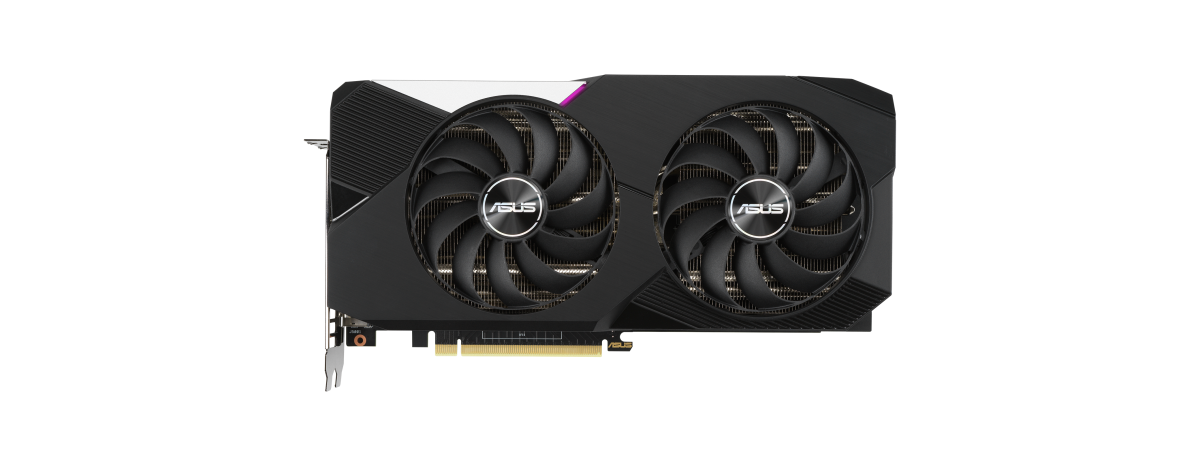
Nvidia’s GeForce RTX 3070 is one of the most popular GPUs in 2022, with many manufacturers implementing it in their customized graphics cards. One of the best cards on the market is the ASUS Dual GeForce RTX 3070 OC Edition. Featuring an excellent cooling system, a beautiful design, and an overclocking mode that you can turn on with a simple switch, this graphics card promises top-notch performance in all your favorite games. If you want to see how the ASUS Dual GeForce RTX 3070 OC Edition fares in games and benchmarks, read this review:
ASUS Dual GeForce RTX 3070 OC Edition: Who is it good for?
This graphics card is an excellent choice if you want:
- To play any game at maxed visual settings in 1440p resolutions
- Good ray tracing performance and access to the DLSS technology
- One of the most balanced graphics cards on the market right now
Pros and cons
Here is what I like about the ASUS Dual GeForce RTX 3070 OC Edition:
- Excellent performance in 1440p resolutions
- Ray tracing performance is good, and it supports DLSS
- 8 GB of GDDR6 RAM is enough if you don’t want to play in 4K resolutions
- The cooling system is excellent
There are a couple of negatives too:
- It needs more electricity than an AMD Radeon RX 6800, its main competitor
- At the time of this review, stores sell this GPU at higher prices than the Radeon RX 6800

Verdict
The ASUS Dual GeForce RTX 3070 OC Edition is one of the best implementations of the RTX 3070 GPU. After using and testing it for a while, I know that it can easily handle any game, no matter how demanding, in resolutions of up to 1440p. It will likely do well in 4K resolutions too, but you might have to decrease some of the visual quality to achieve a good number of frames per second. Overall, ASUS Dual GeForce RTX 3070 OC Edition is a solid mid-range choice for gamers who don’t have the budget for premium graphic cards.
Unboxing the ASUS Dual GeForce RTX 3070 OC Edition
The ASUS Dual GeForce RTX 3070 OC Edition is a relatively large gaming graphics card, and its package is sized accordingly. The box is made of cardboard painted in black, gray, and Nvidia’s green color. There are some pictures and information about the card on all sides of the box, so you can get an idea of what to expect even before opening it.

The packaging used for ASUS Dual GeForce RTX 3070 OC Edition
Inside the box, you get the ASUS Dual GeForce RTX 3070 OC Edition graphics card together with a bundle of documents, including the user manual and warranty card.

Unboxing the ASUS Dual GeForce RTX 3070 OC Edition
The package of the ASUS Dual GeForce RTX 3070 OC Edition looks good, and the contents are exactly what you’d expect. At first impression, the GPU appears to be quite large and well-built.
Design and hardware specifications
The Nvidia GeForce RTX 3070 graphics card is designed for gamers who want to be able to play games mostly in 1440p and 1080p. In these resolutions, it promises to deliver an excellent number of frames per second. Above, in 4K resolutions, the performance you get in gaming depends on what graphics quality you choose and how many frames per second you’re targeting.

The ASUS Dual GeForce RTX 3070 OC Edition
The ASUS Dual GeForce RTX 3070 OC Edition graphics card is powered by an Ampere GA104. Featuring 5888 CUDA cores and 8 GB of GDDR6 RAM on a 256-bit bus width, the GPU runs on a default frequency of 1500 MHz that can be boosted up to 1770 MHz.
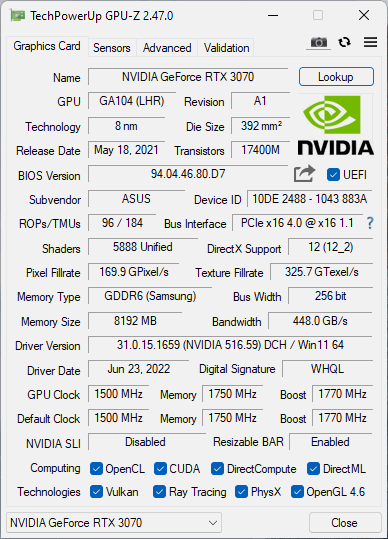
ASUS Dual GeForce RTX 3070 OC Edition: Specifications
Furthermore, ASUS’ implementation features a built-in overclocking mode that allows the graphics card to boost its speed to 1800 MHz. To enable OC Mode, all you have to do is turn the small switch found on the graphics card to Performance Mode.
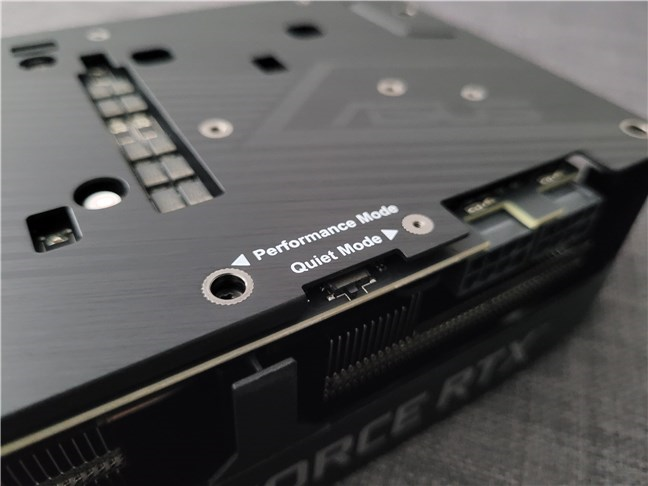
The switch for enabling Performance/Quiet Mode
One of the things that make all RTX 3000 graphics cards stand out, including the RTX 3070, is Nvidia’s DLSS technology and the support for ray tracing. The latter means better and more realistic lighting effects, shadows, and reflections. Unfortunately, all that requires a lot of dedicated processing power from the GPU, which means performance is severely affected when ray tracing effects are rendered.
To ease the load on the graphics card, Nvidia created DLSS (Deep Learning Super Sampling), a technology that uses AI (Artificial Intelligence) to perform a sort of an upscaling of frames. To explain it as simply as possible, Nvidia’s DLSS creates frames in lower resolutions than the one you set in your favorite game. Then, DLSS increases the frames’ resolution while also applying a variety of effects and improvements to it. The end result is a frame that looks similar, if not identical, to what you’d get if the GPU rendered the frame in the original resolution.
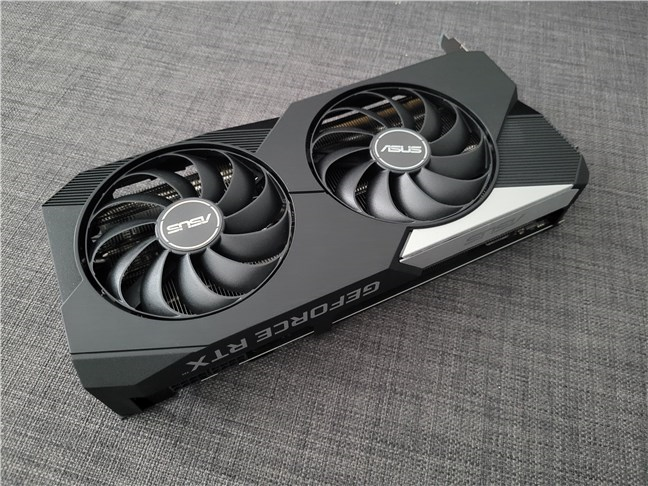
ASUS Dual GeForce RTX 3070 OC Edition supports DLSS
The ASUS Dual GeForce RTX 3070 OC Edition supports a maximum resolution of 7680 x 4320 pixels and has five output ports. Three of them are DisplayPort (1.4a), and two are HDMI (2.1) ports. The total number of displays you can connect is four.

Output ports on the ASUS Dual GeForce RTX 3070 OC Edition
To dissipate heat produced by the graphics card, ASUS chose to use a cooling system with two axial fans. According to the company, this type of fan has a smaller hub, longer blades, and a barrier ring. The consequence is improved airflow and dispersion - check the last part of the benchmarks section in this review to see how hot the ASUS Dual GeForce RTX 3070 OC Edition gets in demanding workloads.

The cooling system on the ASUS Dual GeForce RTX 3070 OC Edition
On the back of the Dual GeForce RTX 3070 OC Edition, ASUS mounted a metallic backplate. It looks good, and it’s not there just to hide the circuit board. It helps with heat dissipation and doesn’t let the card bend easily either.

ASUS Dual GeForce RTX 3070 OC Edition has a metallic backplate
The graphics card supports PCI Express 4.0 and uses two 8-pin PCIe connectors to get the additional electrical power required. By the way, ASUS recommends a 750 Watts power supply unit for the computer in which you mount the ASUS Dual GeForce RTX 3070 OC Edition.

ASUS Dual GeForce RTX 3070 OC Edition uses two 8-pin power inputs
In terms of size, the ASUS Dual GeForce RTX 3070 OC Edition graphics card is, expectedly, a large component. Measuring 10.51 inches in length, 5.31 inches in width, and 2.05 inches in thickness, the card occupies almost three PCIe slots. In the metric system, the size of the GPU is 26.7 by 13.5 by 5.2 centimeters.

ASUS Dual GeForce RTX 3070 OC Edition occupies three PCIe slots
If you want more details about this graphics card’s hardware specs and features, visit this webpage: ASUS ASUS Dual GeForce RTX 3070 OC Edition - Tech Specs.
Performance in games and benchmarks
To see what performance you get from the ASUS Dual GeForce RTX 3070 OC Edition graphics card in real life, I ran a few gaming benchmarks. Then, I compared its results to those of an AMD Radeon RX 6800 that I previously tested on the same computer. Speaking of which, these are the hardware components and software I used:
- Processor: AMD Ryzen 9 5900X
- Motherboard: ASUS ROG Crosshair VIII Hero (Wi-Fi)
- Memory: HyperX Predator DDR4 RGB (2 x 8 GB, 3200 MHz)
- Storage: Kingston KC3000 M.2 NVMe PCIe 4.0 2TB SSD
- Monitor: ASUS ROG Strix XG32VQ (2560x1440, 144Hz)
- Power Supply Unit: ASUS ROG Thor 850W Platinum
- CPU cooler: Cooler Master MasterLiquid ML360R RGB
- Operating System: Windows 11 Pro (version 21H2, build 22000.795)

The test PC used for the ASUS Dual GeForce RTX 3070 OC Edition
Note that all the following games were benchmarked using the high or ultra graphics settings. Also, I didn’t enable DLSS (on the RTX 3070 GPU) or FSR (on the RX 6800 GPU). That’s because I wanted to measure the raw performance offered by the cards without altering results with the upscaling technologies from Nvidia or AMD.
In Shadow of the Tomb Raider, a beautiful game that requires a powerful graphics card to run at maxed settings, the GeForce RTX 3070 OC rendered 164 frames per second in 1080p resolution and 116 fps in 1440p. That’s 13% to 15% fewer fps compared to the AMD Radeon RX 6800, but still top-notch results!

Shadow of the Tomb Raider: Benchmark results
TIP: You keep seeing fps in all these benchmarks we’re running, but do you truly know what this concept means and why it matters? To refresh your memory, here’s a detailed guide on what FPS (frames per second) is.
Next was Metro Exodus, one of the most demanding games ever in terms of graphics performance. Using the Ultra graphics preset, the ASUS Dual GeForce RTX 3070 OC rendered 96 fps in 1080p and 77 fps in 1440p resolution, on average. Both results are excellent, above the 60 fps threshold, and relatively close to what you get from the AMD Radeon RX 6800 (lower fps by 8 ~ 11%).

Metro Exodus: Benchmark results
I continued with Horizon Zero Dawn, a game I like quite a lot, with beautiful Sci-Fi visuals, rich environments, a combat system, and a storyline I enjoy. But, to experience the game at its finest, you need to have a powerful graphics card. The ASUS Dual GeForce RTX 3070 OC managed to render an excellent number of average frames per second: 129 fps in 1080p and 106 fps in 1440p. The results are about 15 percent lower than what I got from the next-tier Radeon RX 6800, but still excellent.
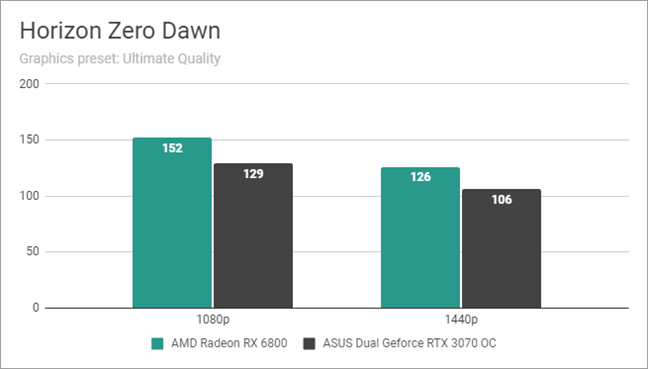
Horizon Zero Dawn: Benchmark results
Moving on, I benchmarked the graphics card in Assassin’s Creed Valhalla. Here, the difference between the RTX 3070 and the RX 6800 was wider. The RTX rendered about 27% fewer frames per second in both 1080p and 1440p resolutions. However, the numbers are still high, easily surpassing 60 fps, which many consider the lower limit for good gaming experiences.

Assassin's Creed Valhalla: Benchmark results
The last game I tried and tested was Deathloop, a game that offers an out-of-the-ordinary gameplay experience and beautiful art design but which requires a powerful graphics card to run well at maxed visuals. The RTX 3070 GPU proved to be up to the task, managing to render 110 fps in 1080p and 87 fps in 1440p. That’s about 8 to 9% fewer frames per second than the AMD Radeon RX 6800, but still excellent numbers!

Deathloop: Benchmark results
Next, I also ran two of the synthetic benchmarks available in 3DMark: Time Spy and Port Royale. The ASUS Dual GeForce RTX 3070 OC obtained an excellent score of 12927 points in Time Spy and a high score of 7929 points in Port Royale. While in Time Spy, its overall performance was lower than that of the AMD Radeon RX 6800, the RTX 3070 outmatched by a smidgen the RX 6800 in Port Royale.
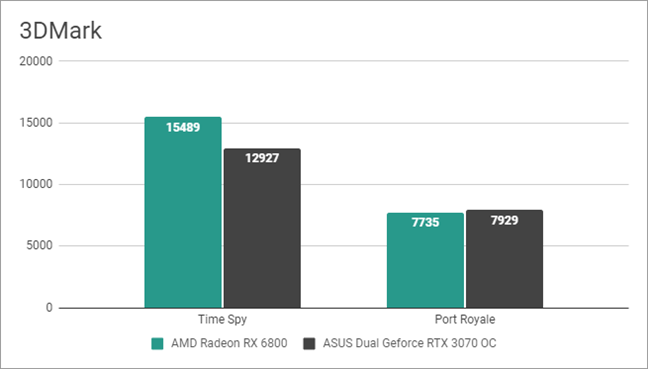
3DMark: Benchmark results
While playing and running benchmarks, I also monitored the temperature and power consumption of the ASUS Dual GeForce RTX 3070 OC graphics card. The maximum temperature reached was 73 degrees Celsius (163.4 Fahrenheit), and the peak power consumption was 239 Watts. The card’s cooling system is excellent, as you can see, but its electricity consumption is slightly higher than that of the AMD Radeon RX 6800, which is more powerful.

ASUS Dual GeForce RTX 3070 OC: Temperatures and power consumption
The ASUS Dual GeForce RTX 3070 OC Edition is an excellent mid-range graphics card. It can run any game in high or ultra visual quality, both in 1440p and 1080p. However, the 8GB of RAM and its general performance don’t recommend it for gaming in 4K unless you’re OK with lowering the graphics quality in your favorite game.
What is your opinion about the ASUS Dual GeForce RTX 3070 OC Edition?
As you’ve seen, the ASUS Dual GeForce RTX 3070 OC Edition graphics card has a lot to offer and won’t leave gamers disappointed, even though it has some tough competition at the moment, in the form of AMD Radeon RX 6800. Before leaving, let me know what you think about this review and this mid-range graphics card. Do you intend to buy it, or are you looking at alternatives?


 01.08.2022
01.08.2022 


